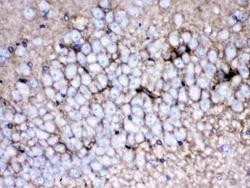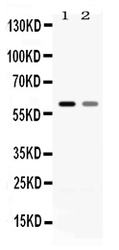Antibody data
- Antibody Data
- Antigen structure
- References [2]
- Comments [0]
- Validations
- Immunohistochemistry [1]
Submit
Validation data
Reference
Comment
Report error
- Product number
- PB9959 - Provider product page

- Provider
- Boster Biological Technology
- Product name
- Anti-EAAT1/SLC1A3 Antibody Picoband™
- Antibody type
- Polyclonal
- Description
- Polyclonal antibody for EAAT1/SLC1A3 detection. Host: Rabbit.Size: 100μg/vial. Tested applications: IHC-P. Reactive species: Human. EAAT1/SLC1A3 information: Molecular Weight: 59572 MW; Subcellular Localization: Membrane; Multi-pass membrane protein; Tissue Specificity: Highly expressed in cerebellum, but also found in frontal cortex, hippocampus and basal ganglia.
- Reactivity
- Human, Mouse, Rat
- Host
- Rabbit
- Vial size
- 100μg/vial
- Concentration
- Add 0.2ml of distilled water will yield a concentration of 500ug/ml.
- Storage
- At -20°C for one year. After reconstitution, at 4°C for one month. It can also be aliquoted and stored frozen at -20°C for a longer time. Avoid repeated freezing and thawing.
- Handling
- Add 0.2ml of distilled water will yield a concentration of 500ug/ml.
Submitted references Tumor necrosis factor-α promotes the expression of excitatory amino-acid transporter 2 in astrocytes: Optimal concentration and incubation time.
Hydrogen-rich saline protects retina against glutamate-induced excitotoxic injury in guinea pig.
Ding Y, Zhang K, Liu S, Zhang Q, Ma C, Bruce IC, Zhang X
Experimental and therapeutic medicine 2014 Dec;8(6):1909-1913
Experimental and therapeutic medicine 2014 Dec;8(6):1909-1913
Hydrogen-rich saline protects retina against glutamate-induced excitotoxic injury in guinea pig.
Wei L, Ge L, Qin S, Shi Y, Du C, Du H, Liu L, Yu Y, Sun X
Experimental eye research 2012 Jan;94(1):117-27
Experimental eye research 2012 Jan;94(1):117-27
No comments: Submit comment
Supportive validation
- Submitted by
- Boster Biological Technology (provider)
- Main image

- Experimental details
- EAAT1 was detected in paraffin-embedded sections of rat brain tissues using rabbit anti- EAAT1 Antigen Affinity purified polyclonal antibody (Catalog # PB9959) at 1 μg/mL. The immunohistochemical section was developed using SABC method (Catalog # SA1022).
- Additional image

 Explore
Explore Validate
Validate Learn
Learn Western blot
Western blot Immunohistochemistry
Immunohistochemistry